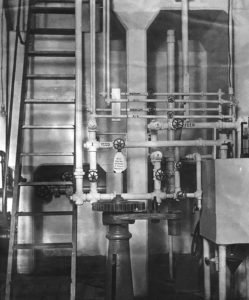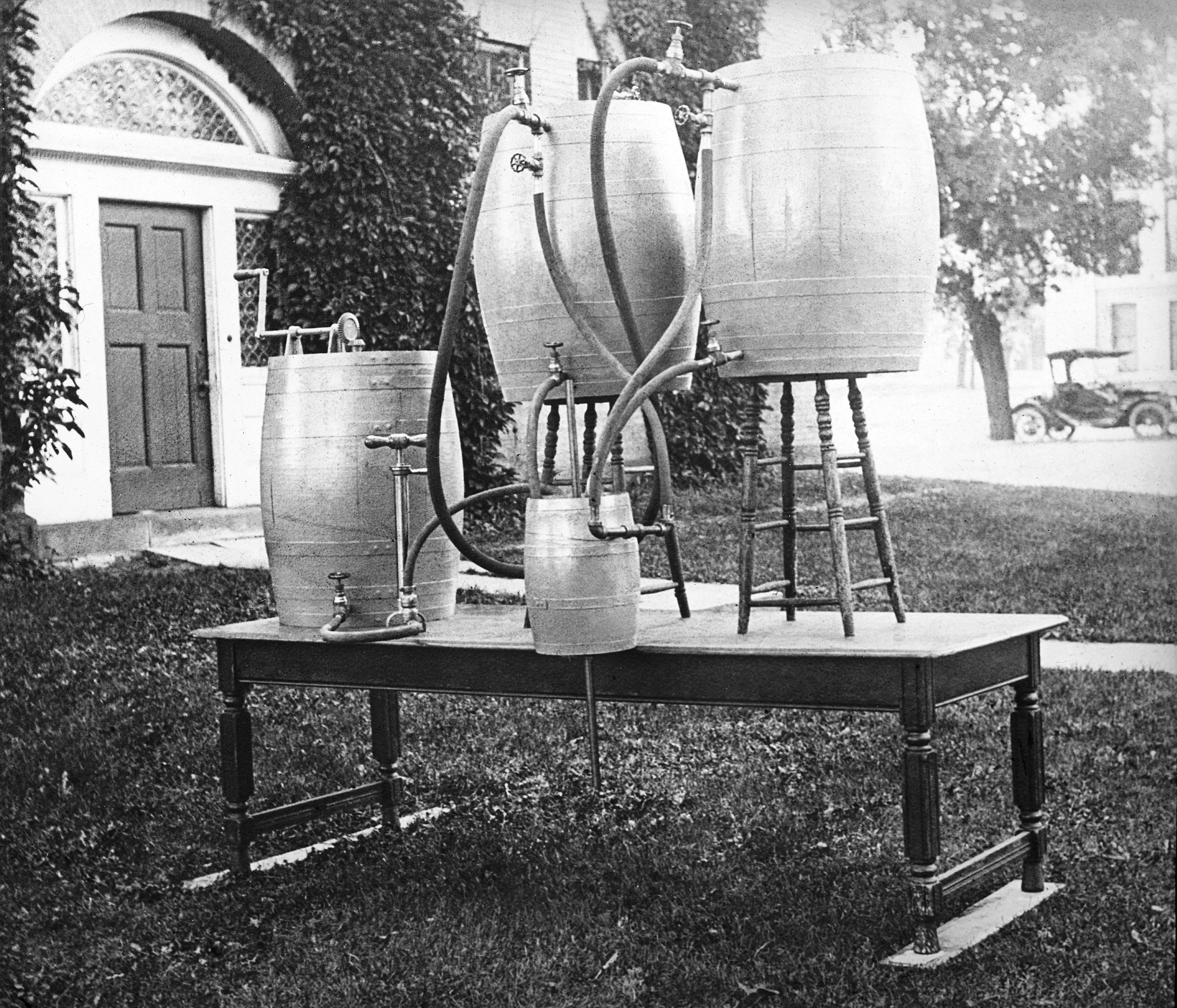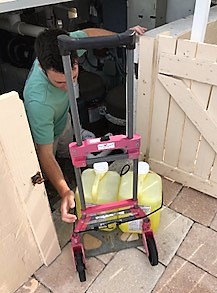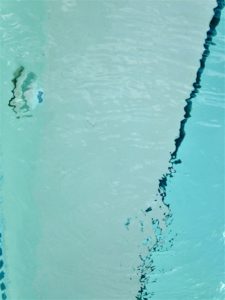
Available Chlorine Content (ACC) is perhaps the most confusing concepts to grasp. The term was created as a means of comparing the bleaching and disinfecting power of the different chlorine compounds. Simplified, ACC is nothing more than a comparison of that specific chlorine type to chlorine gas and really does not have much to do with how much chlorine is in the bucket. This measurement applies to that chlorine type as a whole, meaning that all chlorine of that type is this strength (or within that specific range of strength) compared to Chlorine gas, which is always 100 percent. Confusing? If we want to know what amount of the chlorine type is actually in the bucket you are purchasing, we will need to look at the listed Percent of Active Strength.
If we were to look at standard chlorine tablets, trichloro-s-triazinetrione (Trichlor): Available in either granule or tablet form. The compound (C3Cl3N3O3) is 90% Available Chlorine. This means that Trichlor is 90% as strong as chlorine gas. This applies to ALL Trichlor, ALL Trichlor is 90% ACC (Available Chlorine Content). The 90% listed serving as a comparison of the compounds as explained above. The product is also listed as > 99% active strength. This means that greater than 99% of what is in the bucket is actually trichloro-s-triazinetrione, the amount of the active ingredient.
Nowadays, Chlorine tablets (Trichlor) are not typically manufactured using binders to hold the product together in tablet form. High-pressure equipment presses the compound into shape; it is strictly a lot of psi used to maintain that tablet form. Back in the day this was not always the case and binders such as xanthan gum were utilized to allow the product to maintain its shape. Still, tablets are often falsely accused due to the “gummy” build up found in erosion feeders (automatic chlorinators) following use. This, however, is due to zinc stearate which is used during production as more of a lubricant to keep the tablets from sticking to the manufacturing press; not as an actual ingredient. Think of its use as more similar to the reason one would use Pam cooking spray in a skillet.
In a quasi-similar (but not exactly the same) example, Bacardi 151 was 75.5% alcohol by volume; 151 Proof. If a bartender was to make a rum and coke utilizing one shot of Bacardi 151 and another with two shots of 151, the strength of the active ingredient (Alcohol Proof) does not change, the rum is still 151 Proof. The only change was in the amount of the Bacardi product to Coca Cola.
The product itself; a stabilized compound: contains cyanuric acid (stabilizer). This is evidenced in the formula C3Cl3N3O3 , the Cl3 (3 atoms of chlorine) displacing H3 (3 atoms of hydrogen) in the cyanuric acid compound C3H3N3O3. Therefore, we do add more than just chlorine nonetheless. 15 oz. of trichlor (stabilized chlorine tablets/granular) will add 10 ppm of FAC to 10,000g, but it will also increase the CYA (Cyanuric Acid) by 6 ppm and the TDS by 10 ppm. The product itself is also acidic with a pH of 3.0 and will, when used for chlorination result in lowering pH. Trichloro-s-triazinetrione has an indefinite shelf life and, in storage, will never lose any of its ACC.

Sodium Hypochlorite (NaClO) has a Trade% of 10 to 12 (Volume % Available Chlorine). The rest is simply saltwater (the inert ingredient). A gallon of sodium hypochlorite (containing 2.34 pounds of solids) will add 12 ppm of FAC (Free Available Chlorine) to 10,000 gallons of water and will increase the TDS by 28 ppm. Sodium Hypochlorite (liquid chlorine) has a very short shelf life and drops to 8% ACC within several weeks of manufacture (household bleach from the supermarket has a 6% ACC). Sodium Hypochlorite, despite popular belief, does not increase pH; (except possibly in instances where manufactured with excess lye) as is the same with other hypochlorites (Calcium Hypochlorite, Lithium Hypochlorite, etc).
Confusing Terms for Weight %, Trade % and Available Chlorine
Weight % Available Chlorine = Trade % ÷ Specific Gravity
Trade % = Weight % Available Chlorine × Specific Gravity
Weight % NaOCl (sodium hypochlorite) = Weight % Available Chlorine × (NaOCl grams/mole)/(Cl2 grams/mole)
Weight % Available Chlorine = Weight % NaOCl × (Cl2 grams/mole) / (NaOCl grams / mole)
Weight % NaOCl = (Trade % / Specific Gravity) × (NaOCl grams/mole) / (Cl2 grams/mole)
Weight % NaOCl = (12.5/1.16) × (74.442/70.906)
Weight % NaOCl = (10.7759) × (1.0499) = 11.3136
Trade % = Weight % NaOCl × Specific Gravity × (Cl2 g/mole) / (NaOCl grams/mole)
Trade % = 11.3136 × 1.16 × (70.906/74.442)
Trade % = 11.316 × 1.16 × (.9525)
Trade % = 12.50
NaOCl grams/mole = 74.442
Cl2 grams/mole = 70.906
Liquid bleach is usually a Weight % NaOCl in the ingredients on the label and sometimes (for Clorox, for example) lists the “% Available Chlorine.” Liquid pool chlorine is most often sold by Trade %. The Trade % is technically the Volume % Available Chlorine and therefore is the only quantity that exactly matches its number with ppm in the pool water as with 1 gallon in 10,000 gallons of 12.5% chlorinating liquid produces 12.5 ppm
free chlorine.

Calcium Hypo (Ca(ClO)2) has a 48 to 72% ACC and a corresponding Active Strength of 48 to 72%. The inert ingredient in Calhypo is calcium chloride. Calhypo (Calcium Hypochlorite) added at a rate of 20 oz. per 10,000g will add 10 ppm of FAC, but will also increase your Calcium Hardness by 8 ppm and your Total Dissolved Solids by 15 ppm. It will take roughly three years before Calcium hypochlorite begin to lose any of its ACC, and then it does so at an extremely slow rate. Calcium Hypochlorite, as explained above with all hypochlorites, does not increase pH. The increase in pH is only temporary (except as noted above with sodium hypochlorite) because the pH of hypochlorites is high. However, when chlorine is “used up” the process is acidic, bringing the pH back down to pretty much where it started.
To reiterate, using Trichlor as an example, at 90% ACC (Available Chlorine Content) and > 99% active strength = greater than 99% of what is in the bucket is trichloro-s-triazinetrione, it’s just that the trichloro-s-triazinetrione in the bucket is only 90% as strong as chlorine gas.
Similar Article: That Chlorine Smell ?
Special thanks to Robert Lowry, chemical consultant and pool/spa water chemistry expert, for the peer review and contributions to this article.
Confusing Terms for Weight %, Trade % and Available Chlorine: Page 128 © Copyright 2018 Lowry Consulting Group, LLC All rights reserved. Duplicated with permission, Pool Chemistry for Residential Pools
Photo Credit: Historic photographs Minnesota Department of Health, R.N. Barr Library; Librarians Melissa Rethlefsen and Marie Jones







This is a great article and very informative. Have this bookmarked for future use.
Thank you Christine. Thank you for reading!
Educational and enlightening as always!
?
I been using liquid chlorine but after this hot and rainy weather we been having in FL
I just switched to cal hypo.
? Thank you for reading!
Wow, an actual scientific approach! Well done!
Thank you Maria! I am glad you enjoyed the article ?
Very informative and helpful.
Thanks Ronald!
That was very informative. I learnt so much things from here. Thanks for the write-up, Rudy!
Priya – Thank you, and thank you for reading ??
Pingback: Bromate from Bromine - Pool Operator Talk News🗞